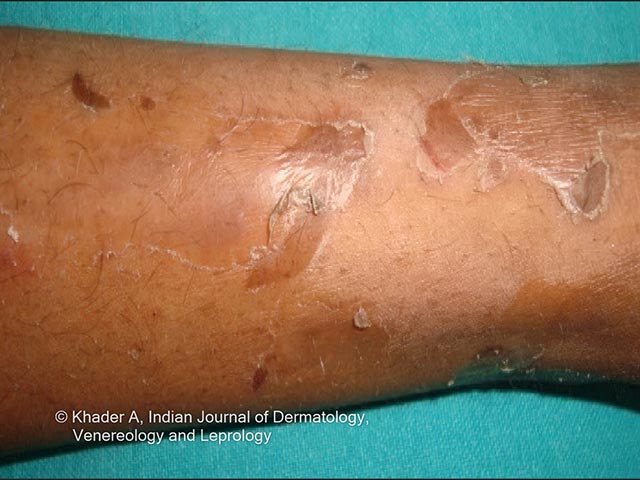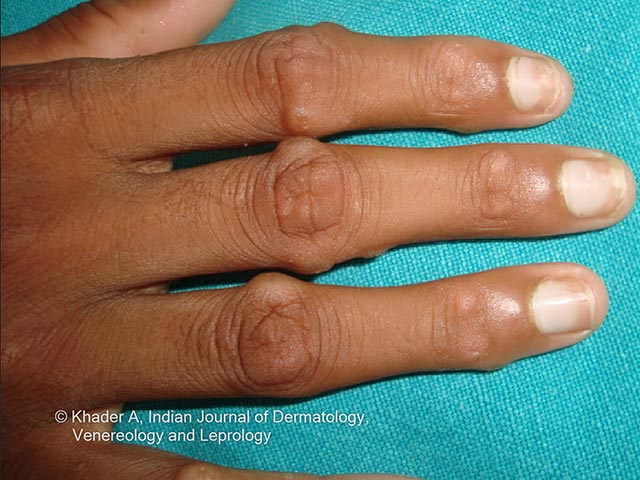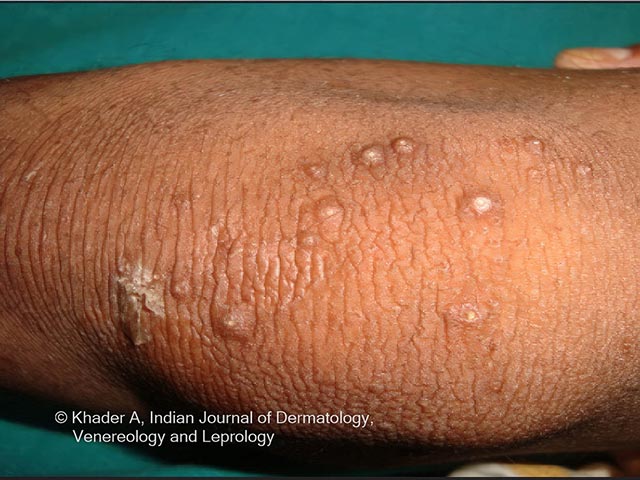Main menu
Common skin conditions

NEWS
Join DermNet PRO
Read more
Quick links
PLACK syndrome — extra information
Genetic Connective tissue diseases
PLACK syndrome
Last Reviewed: October, 2024
Author(s): Roy Kingsley Wong, The Royal Adelaide Hospital, Australia; Dr Vidette Wong, Specialty Doctor, Belfast, Northern Ireland (2024)
Reviewing dermatologist: Dr Ian Coulson
Edited by the DermNet content department
Introduction
Demographics
Causes
Clinical features
Variation in skin types
Diagnosis
Differential diagnoses
Treatment
Prevention
Outcome
What is PLACK syndrome?
PLACK syndrome, a form of generalised peeling skin syndrome (PSS), refers to an extremely rare autosomal recessive genodermatosis that is associated with the loss of function mutations in the CAST gene which encodes calpastatin. PSS was previously considered a subtype of epidermolysis bullosa simplex, however it is now classified as a separate disorder of skin fragility.
PLACK is an acronym for:
- Peeling skin
- Leukonychia
- Acral punctate keratosis
- Cheilitis
- Knuckle pads
Who gets PLACK syndrome?
PLACK syndrome is an extremely rare autosomal recessive subtype of peeling skin syndrome. Initially recognised by Lin et al in 2015, there are less than 15 reported cases of PLACK syndrome to date based on a literature review. There appears to be an equal gender distribution, and onset typically manifests during infancy.
What causes PLACK syndrome?
PLACK syndrome is caused by the loss of function mutations in the CAST gene, which encodes calpastatin.
To date, the following variant mutations and their encoded protein has been identified in the CAST gene:
- c.424A>T, p.Lys142*
- c.607dup, p.lle203Asnfs*8
- c.1750delG, p.Val584Trpfs*37
- c.461dupGCAT, p.Ser154Cysfs*6
- c.507_508insA, p.Glu172Argfs*11
- c.544G>T, p.Glu182*
- c.571G>T, p.Gly191*
- c.565-11A>G
- c.1423-6G>A, p.Asp475llefs*3
- c.1897-7A>G, p.Leu570*
- c.1148T>G, p.Leu383*
- c.1209+2T>G, p.Pro404Alafs*4
Calpastatin serves multiple functions, including promoting keratinocyte proliferation, epidermal differentiation and cornification, and apoptosis. In PLACK syndrome, the loss of calpastatin, a calpain inhibitor, leads to overactivity of calpains. Caplain upregulation results in the degradation of essential components of desmosomes or corneodesmosomes, leading to compromised adhesion thought to cause skin peeling and fragility. The role of CAST mutations and their manifestations in PLACK syndrome are still not completely understood.
What are the clinical features of PLACK syndrome?
In PLACK syndrome, symptoms may manifest from birth or an early age.
Clinical features include:
- Painless skin peeling that may be accompanied by blistering — often generalised, although there may be a predilection for extremities
- White discolouration of nail plates (leukonychia)
- Acral punctate keratosis — tiny bumps of thickened skin on the palms and soles
- Inflamed lips (cheilitis)
- Thickening of skin over joints such as the fingers, knees, or toes — known as knuckle pads.

Skin peeling seen in PLACK syndrome (PLKS-patient 1)

Hyperkeratotic nodules and proximal leukonychia in PLACK syndrome (PLKS-patient 1)

Angular cheilitis seen in PLACK syndrome (PLKS-patient 1)

Hyperkeratotic papules on the extensor aspect of the knee in PLACK syndrome (PLKS-patient 1)
Photos courtesy of Dr AS Vidya, Kerala, India
Click here for more images of PLACK syndrome
How do clinical features vary in differing types of skin?
Given the scarcity of documented cases, a comprehensive understanding of clinical features across various skin types has not yet been established.
What are the complications of PLACK syndrome?
As a result of the limited long-term research on PLACK syndrome, no confirmed complications have been definitively associated with this condition.
Cases of sudden cardiac death were reported in some individuals with PLACK syndrome in one wider family. However, a dual diagnosis was considered as the families were consanguineous.
How is PLACK syndrome diagnosed?
PLACK syndrome exhibits phenotypic homogeneity, which greatly assists in diagnosis. The presence of its characteristic features would support a potential diagnosis, and genetic testing for mutations in the CAST gene would be confirmatory.
What is the differential diagnosis for PLACK syndrome?
- Keratolysis exfoliativa
- Erythrokeratolysis hiemalis
- Other subtypes of peeling skin syndrome
- Epidermolysis bullosa
What is the treatment for PLACK syndrome?
There are currently no established effective treatments for PLACK syndrome, given the limited reported cases.
Supportive measures may include:
- Patient education — avoidance of exacerbating factors such as heat, friction, mechanical trauma, or perspiration, which can worsen skin peeling, acral punctate keratosis, and cheilitis
- Topical emollients
- Topical steroids
- Calcineurin inhibitors — for pruritus
- Oral acitretin — trialled in one case report to soften acral keratotic papules; this did not help the other manifestations of PLACK syndrome
- Intravenous lipid infusions containing fat-soluble vitamins — single report of 4-month treatment trial resulting in an objective improvement in pruritus and skin lesions.
How do you prevent PLACK syndrome?
PLACK syndrome, being an autosomal recessive genodermatosis, requires both parents to carry a loss-of-function CAST mutation. In suspected cases, genetic testing should be conducted and may be useful in informing future family planning.
What is the outcome for PLACK syndrome?
Given the limited availability of long-term data, the prognosis for PLACK syndrome remains uncertain. While the majority of documented cases involve younger individuals, there are also reported cases in patients aged 30 and above.
Bibliography
- Hu B, Gong Z, Peng S, et al. PLACK syndrome caused by novel pathogenic variants in CAST: a case report and literature review. Clinical and Experimental Dermatology. 2023;48(9):1052–105. doi: 10.1093/ced/llad167. Journal
- Lin Z, Zhao J, Nitoiu D, et al. Loss-of-function mutations in CAST cause peeling skin, leukonychia, acral punctate keratoses, cheilitis, and knuckle pads. Am J Hum Genet. 2015;96(3):440–447. doi: 10.1016/j.ajhg.2014.12.026. Journal
- Mamivand A, Zekri A, Maghrouni A, et al. A patient with PLACK syndrome with a novel splicing mutation in CAST: the evidence for a loss-of-function mechanism through mis-splicing. Clinical and Experimental Dermatology. 2023;48(10):1160–1164. doi: 10.1093/ced/llad185. Journal
- O’Sullivan S, Ozoemena L, Liu L, et al. PLACK syndrome: the penny dropped. Clinical and Experimental Dermatology. 2020;45(8):1091–1092, doi: 10.1111/ced.14417. Journal
- Potz BA, Abid MR, Sellke FW. Role of calpain in pathogenesis of human disease processes. J Nat Sci. 2016;2(9):e218. Article
- Sawan ZA, Almehaidib A, Binarner Y, et al. PLACK syndrome is potentially treatable with intralipids. Clinical Genetics. 2021;99(4):572–576. doi: 10.1111/cge.13919. Journal
